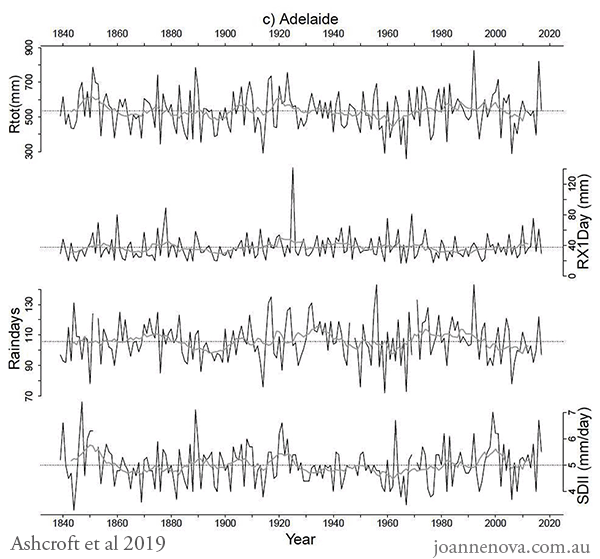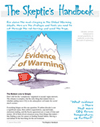Remarkable! A new study by Ashcroft, Karoly and Dowdy pieces together an extraordinary 178 years of rainfall data from Sydney, Melbourne and Adelaide. This is a rare study that brings in much older data, looking at trends and extremes. This is pretty much the ultimate long term rainfall paper for South East Australia. Henceforth, there shalt be no more headlines about “unprecedented” rainfall or area’s drying out “due to climate change” unless an event rates against this data…
Australia – a land of floods and droughts:
- Rainfall goes up and down in long ongoing cycles or change, but no obvious trend that matches the sharp rise of CO2 in the last 30 years. It’s almost like CO2 has no detectable effect…
- The worst extremes were for the most part — long ago — particularly in the 1840s (assuming those records are reliable).
- Almost nothing in the last 30 years is unusual or unprecedented despite humans putting out 50% of all our CO2 since 1989.
- These charts show how misleading it is to use graphs that start in 1970 (or even in 1910) and declare that the recent changes are meaningful, or caused by CO2.
The researchers also use newspaper archives to describe these wild events. Some extracts below and the three key graphs. Normally this would be forgotten history, so it is excellent to see these old records being studied. — Jo
Sydney’s wettest year was 1950, driest year was 1849
Sydney’s wettest year occurred in 1950, while the driest year was recorded in 1849. Two very wet events for Sydney are apparent in the early 1840s — one in April 1841 when 20.12 inches (511 mm) was recorded at Port Jackson, and another in October 1844 when 20.41 inches (518 mm) of rainfall was observed at South Head in one day and night on the 15th– 16th. The Government Gazetteabstract for April 1841 described the deluge as “a most violent storm of rain”, and The Sydney Gazette reported extensive damage to buildings and roads as a result of the downpour (The Sydney Gazette, 1 May 1841, page 2, and 4 May 1841, page 2, available at http://nla.gov.au/nla.news-article2553198 and http://nla.gov.au/nla.news-article2553217).

Rainfall trends, cycles, Australia, Sydney, Graph, 2019, 1840 – 202
Abbreviations: Rainday counts (RD), monthly rainfall totals (Rtot), and highest daily rainfall (Rx1day).
The Simple Daily Intensity Index (SDII): the amount of rainfall received divided by the number of raindays recorded over a month and year.
Melbourne – wettest year and day was 1849
The Millennium Drought stands out as the driest period in the complete record, as noted in other studies of climate change in the region (Hope et al., 2017). The driest year occurred in 1967, at the start of three-year period of dry conditions (Fig. 3b).
Periods of wet conditions, such as the 1950s, are also associated with rainday increases. The wettest year in Melbourne’s history seems to have occurred in 1849, and included the wettest day in the extended record, when 7 inches (177 mm) was recorded on the 27th of November. The Government Gazette table reported rain from the 25th to the 28th of that month, with gales on the 27th. Newspapers at the time wrote that the event caused “Appalling Destruction of Life and Property”, claiming that the Yarra River “attained an unprecedented height” on the 28th (The Courier, 8 December 1849, p 2, available from http://trove.nla.gov.au/ndp/del/article/2964223).Flooding killed several residents and thousands of sheep, creating havoc for much of the settlement (The Courier, 8 December 1849).

Rainfall trends, cycles, Australia, Melbourne, Graph, 2019, 1840 – 2020
Adelaide — wettest day was 1925
The wettest Adelaide day occurred on 6 February 1925, when 141.5 mm of rainfall was recorded in 24 h to 9am on 7 February due to a severe thunderstorm. Newspaper accounts at the time reported a “Tropical Downpour in Adelaide: A record fall of over five inches in two and a quarter hours” that had the “streets running like rivers”…
Adelaide rainfall (Fig. 3c) displays prolonged wet periods in the 1850s and 1920s, with dry periods apparent during the turn of the 20th century and the 1960s. The wettest year occurred during 1992 due to a very wet austral spring (seasonal analysis not shown), while the driest year occurred in 1967.
Abstract
The cities of Melbourne, Sydney and Adelaide are home to almost half of the Australian population, and are often exposed to extreme rainfall events and high year-to-year rainfall variability. However the majority of studies into rainfall in these cities, and southeastern Australia in general, are limited to the 20th century due to data availability.
In this study we use rainfall data from a range of sources to examine four rainfall indices for Melbourne, Sydney and Adelaide for 1839–2017. We derive the total rainfall, number of raindays, wettest day of the month and the simple daily intensity index for each city over the past 178 years, and find relatively consistent relationships between all indices despite potential data quality issues associated with the historical data. We identify several extreme daily rainfall events in the pre-1900 period in Sydney and Melbourne that warrant further examination as they appear to be more extreme than anything in the modern record.
We find a moderate and relatively stable relationship between El Niño–Southern Oscillation (ENSO) and annual variations of total rainfall and the number of raindays at all three cities over the research period, but no relationship between ENSO and the annual wettest day, in agreement with other studies using shorter time series.
Conclusion
This paper describes rainfall in three of Australia’s largest cities for the last 178 years using several mean and extreme rainfall indices. Combining historical daily observations and summary tables back to 1839 with modern records, we have been able to explore not only mean rainfall, but the occurrence and intensity of the extreme rainfall events for Melbourne, Sydney and Adelaide. Extreme rainfall events are likely to be associated with flooding and damage, noting that flood risk in cities is largely due to rainfall rather than other factors, such as soil moisture, which are important in other areas.
Issues with data quality and changes in observation location make it difficult in some cases to determine the accuracy of the absolute rainfall totals recorded. For example, the statistical differences between the historical and modern data for Melbourne and Sydney appear to be largely due to several extreme events in 1840–1860 period. Given the good agreement between the instrumental and documentary information, these events are undeniably extreme, but further examination could potentially help determine how accurate the absolute rainfall observations are.
h/t Willie
REFERENCE
LindenAshcroftabDavid J.KarolyacAndrew J.Dowdyb(2019) Historical extreme rainfall events in southeastern Australia, Weather and Climate Extremes Available online 10 May 2019, 100210











Good stuff! Note that values near the average are rare, so calling the average “normal weather” is very wrong. What is normal is for the weather to be far from the average. This is the footprint of a chaotic system, which weather is well known to be. Notice too that many-decade cycles are common, which is why calling short term trends “climate change” is wrong.
441
This is very important. The average of a sine wave over a Chery picked single cycle is zero but a sine wave is almost never zero. The integral of a sine wave is a cosine wave which is also almost never at its full cycle average average. Over any period other than a cycle, the average of a sine wave is different. Just like climate.
You can’t characterise climate by averages, nor can you characterise climate using a scalar models (simple numeric model without dynamuc/frequency components). You need a complex model using complex number math to describe these systems and for one of those you need to know all of the feedback paths, their delays, and magnitudes.
We have nowhere near the level of knowledge for a feedback model of the climate, only one feedback is even discussed, some of the feedbacks are even dependent on the temperature which makes them more unstable. Some feedback is non linear for example exhibit thresholds or hysteresis. Humidity is like that at a certain combination of temperature, air pressure and humidity (the dew point) water vapour condenses spontaneously. In formation of storms the trajectory of weather parameters is vastly different to the return of those parameters. IE the path up in temperature is different to the path down – that’s non linear.
Current scalar models are therefore totally inadequate to describe the system they are modelling
171
‘You can’t characterise climate by averages, nor can you characterise climate using a scalar models’, good statement Bobl, so true.
Another thing in the so called models is the use of fluid equations, like Navier Stokes equations, of which are impossible to solve and bear no relavence in wide grids.
Since the entire system is solar driven anyway which makes it pretty much impossible to predict with any certainty, even hard on short timescales.
Averaging the planets surface temperature is always bothered me and is totally ridiculous.
153
What happens during the day is one thing.
At night there’s another system entirely.
You can’t average that, but they did.
KK
71
Spot on KK – “you can’t average that, but they did”. The day when every square kilometer on this planet has a weather station (or dedicated satellite), I will perhaps pay attention to a global average temperature. Absolutely ridiculous. In December 2016 two weather stations recorded these temperatures on the same day: Siberia (-53) and Sahara (+53). Ave temp: zero.
121
With regard to Navier-Stokes I suggest you look at the work of Prof Claes Johnson a world respected mathematician at KTH in Sweden. He was awarded the Prandtl medal for his work on aerodynamics.
You could look here https://claesjohnson.blogspot.com/search/label/Navier-Stokes
The following is from his book the secret of flight
“It is possible to computationally solve the Navier-Stokes equations in the case of high Reynolds number of aerodynamics, using a slip boundary condition as a model of a turbulent boundary layer with small skin friction.
It is possible to theoretically understand high Reynolds number bluff body flow as potential flow modified by rotational slip separation.”
Prof. Johnson has written about quantum physics, the 2nd law of thermodynamics, the nonsense of backradiation and so-called global warming. See his lastest posts here https://claesjohnson.blogspot.com/
30
RealU if you go here http://milesmathis.com/updates.html you will find papers about predicting solar cycles and information from measurements that confirms the predictions. It makes some sense to me. I have found that in SOI data there is a 28 day moon cycle. I found that there is a relation between the tides at Darwin and the SOI. SOI looks at the pressure difference between Darwin and Tahiti. If you look at Tides at Tahiti there are no changes in sea level or tides because of its location of eastward and westward flow in the Pacific. So that gets back to the relation between Darwin tides and SOI. If Mathis is right El Ninos could well be related to movements in the sun due to the alignment of planets.
Now with rainfall I have 126 years of monthly rainfall near my place in SE Qld. I have found that rainfall is or close to a Poisson distribution where the lowest rainfall in any month is zero and the average and the standard deviation are nearly same. The maximum rainfall of any month is something like 7 Std Dev. The highest rainfall in any month occurred in Feb 1893 at 1819mm when there was a cyclone over the Brisbane -Sunshine Coast area called the Mooloolah event. The driest year occurred in 1902 during the federation drought.
If you look here https://www.longpaddock.qld.gov.au/seasonal-climate-outlook/rainfall-probabilities/ you will find that for Qld that rainfall predictions are being made based on phases of the SOI. Somewhere on the longpaddock site will will be able to find charts in a big pdf file of Australia wide rainfall in decades going back I think to 1900 and with it there is a SOI chart.
40
Should have looked harder here is the poster with all the charts which you can download https://www.longpaddock.qld.gov.au/rainfall-poster/
10
At our present state of knowledge, such uncertainly is sure true enough. But, hey, we’re getting there. The last four to five years alone has seen our knowledge of space weather and its actions and effects on terrestrial weather expand enormously. We have gained much fresh understanding.
The new generation of satellites with newer, better and better still sensors are giving us lots of better, newer and fresher knowledge. Other research hasn’t stood still; it was only four years ago we learned the solar cycle was governed by two slightly out of phase internal magnetic dynamos, not just one. That alone explains so much!
It takes time and will take more time, but we’re sure making progress.
20
Melbourne’s three on-river reservoir’s inflows match the Sunspot cycle. Simple. Its that big yellow ball in the sky. This takes a few minutes to see. However, it does not do well in the “look-into-it” climate change industry.
91
Ge0ff @ #1.2 said
That’s probably because the “Solar Interference” is not yet sufficiently well researched and understood. TSI (Total Solar Irradiance) is now accompanied by SSI (Stratospheric Solar Irradiance) and the atmospheric charged particle formation of GCRs are receiving some attention. Finally and at long last, the general understanding that the Sun is not constant seems to be sinking in.
It’s not yet enough to get past that phrase “not sufficiently understood” and the hand waving from it …
At least TSI being the only and sole solar influence is now not the case … so one day we may hope for better and more complete understanding.
61
“Normal” in weather lingo is a formally defined term. The average value of a meteorological element over 30 years is defined as a climatological normal.
It means an average of 30 years of a measured item with the last year of the 30 ending with a zero. The span of 1931 – 1960 has been used. Then 1941 – 1970. Then 1951 – 1980.
Current climatological normals are averages from 1981 – 2010.
In a couple of years there will be a new set.
Anyone using something other than the averages so calculated ought not to use the term “Normal.”
Do not think of this use in the same sense you might question whether a person’s normal outlook on life was as an optimist or a pessimist. What’s to compute, or average, regarding outlook?
31
As long as I remember
The rain’s been comin’ down
Clouds of mystery pourin’
Confusion on the ground
Good men through the ages
Tryin’ to find the sun
And I wonder, still I wonder
Who’ll stop the rain?
H/tCreedence cleerwater revival
150
This post and the research underpinning it seems to be strongly correlated with the recent election results.
Good news to have a comment like this;
“It’s almost like CO2 has no detectable effect…” given validity.
KK
140
Here is my way of saying it: https://www.cfact.org/2018/01/02/no-co2-warming-for-the-last-40-years/.
60
Must be close to1000 times that I have pointed out that there was no atmospheric warming from 1980-1997, and no atmospheric warming from 2001-2015
This applies even to the AGW adjust RSSv4
https://i.postimg.cc/fyv8vcRh/RSS_V4_before_El_Nino.png
https://i.postimg.cc/SxQy4C6M/RSS_V4_2001_-_2015.png
That means the ONLY warming has come from El Nino events…
.. this TOTALLY discounts atmospheric CO2 as being a cause of the slight atmospheric warming in the last 40 years
230
Very glad someone else has noticed this. So if the surface has warmed for some reason (other than ad hoc adjustments) it cannot be from the CO2 increase, because that increase only operates in the atmosphere. There is no way for the CO2 increase to warm the surface except by warming the atmosphere and that simply has not happened.
122
CO2 warming had been totally debunked by real physics.
141
This morning the Today show has been rabbiting on about how WA reefs are at the lowest count evahhhhh. The cause as usual ( completely without evidence ) is climate change that hasn’t happened for 30 years (IE warming is no more than 0.1 degrees)
The thing that gets me is the dumb media, doesn’t cotton on to the fact that a warming effect that is supposed to be uniform across the planet from a well mixed gas can cause pools of water several degrees hotter than the rest of the ocean. This requires believing in the fantasy that heat energy can flow from colder places to warmer ones.
Junk science from glorified scuba divers calling themselves scientists, a physics free zone.
171
Attribution my dear fellows, attribution.I will read the paper later but I’m astonished at its candidness-with no politics.Is this a return to real science?
40
With David Karoli on board, I doubt it!
61
Yes – I’m sure Karoly will be rethinking/correcting his numerous accounts of increased rainfall (sarc)e.g. … “For extreme short-timescale rainfall it is very easy to show a link,” said David Karoly, leader of the earth systems and climate change hub at Australia’s National Environmental Science Program. “As the temperature rises, the atmosphere holds more moisture, which is likely to lead to changes in the amount of rainfall.” https://www.bloomberg.com/opinion/articles/2018-09-16/extreme-weather-like-hurricanes-can-be-linked-to-climate-change
50
Yep, I am very surprised to see Karoly’s name on this. The last time I emailed him online, he stated his next project was to “re -adjust the Central England Temperature Record”. A Junk Scientist attempting to junk science…
91
Those graphs look like random chaotic processes to me. Hmmf.
31
Chaotic yes, random no. It is a natural aperiodic oscillator,. But the important thing is ether are no trends, contrary to the climate models.
51
True, I wasnt referring to long term random nature.
All oscillations require a driving force, the climate/weather cant drive itself.
11
And it has Karoly as an author!
50
I looked up the meaning of fr@ud.
It had a photo of greenie Bob Brown and his believers …
“GREENS leader Bob Brown says the coal mining industry should foot the bill for the floods because it helped cause them.”
https://www.news.com.au/breaking-news/coal-miners-to-blame-for-queensland-floods-says-australian-greens-leader-bob-brown/news-story/cbfe12042fa9c4149ea3c10524f57344
101
The coal miners didn’t force people to build houses in areas at risk of flooding, like flood plains
120
“And if the blind lead the blind, both shall fall into the ditch.”
(Matt 15:14)
Nuff said.
70
Karoly..as in David Karoly?
50
From above
“LindenAshcrof, David J.Karoly Andrew J.Dowdyb(2019) Historical extreme rainfall events in southeastern Australia, Weather and Climate Extremes Available online 10 May 2019, ”
(With some trouble in copying superscripts etc)
30
My take is that they were looking to confirm their biased view of increasing frequency of severe weather events. It appears the data let them down.
Karoly will lose his favoured position in the Michael Mann fan club after this publication. It is now apparent that the rainfall data needs homogenisation. The problem here is that there is no clear view on how it should be homogenised. Most climate models show SE Australia as drying but that is not universal. Making adjustments that can cluster data to produce wider extremes is more difficult than simple routines that lower the past temperature.
151
“Ho Ho !
Ho Ho !
It’s off to work we go !
Hoooomogenising rainfall
Across the global Earth !
To make our models work”
We don’t care if we are lying
We have to save the world”
Song of the Climate Change dwarves !
51
Yes looking at the author Linden Ashcroft’s website
and she retweets a lot of climate change stuff
https://twitter.com/lindenashcroft
20
I am waiting for the BOM to claim that the old records are unreliable as the inch wasn’t standardised until 1910 and many of the measurements since then need to be homogenised because of the introduction of metrics.
50
And possibly the cubit was still in use until 1910.
20
It would be nice to see the good Dr Karoly go one step further and plot Rtot(mm) vs atm CO2 concentration over the same period. I bet the correlation coefficient would be close to 0.5
51
Anything less than 0.95 is irrelevant isn’t it?
10
0.95 or better is very good correlation. 0.8 or better would indicate some correlation but 0.5 means zero correlation.
20
It’s been 17 years since I did stats.
10
Re Co2 to blame? I have a paper in hard copy by Professor Alexander, ‘A critical assessment of current climate change science.’ (April 2006) that I downloaded in 2011, but I can’t get Google to retrieve it. It is a detailed study of the river flow of the Vaal River, South Africa’s major river, and its synchronicity with the double sunspot cycle such that Professor Alexander was able to predict the South African floods of 1995 and 2006. I have found some of its significant data reproduced in a shorter publication by Alexander on Professor Pielke’s blog. It includes in its Tables 9 and 10, on pp 23/24 of the original paper. Figure 9 is very important. It demonstrates the unequivocal synchronous relationship between annual sunspot numbers and the annual flows in the Vaal River. Note the alternating above (rising) and below (falling) flow sequences. Note also their synchronous relationship with sunspot numbers; as well as the statistically significant (95%), 21-year periodicity in the flow data that is synchronous with the double sunspot cycle.
https://pielkeclimatesci.wordpress.com/2010/05/20/climate-change-the-west-vs-the-rest-by-will-alexander/
Professor Alexander observes that in a number of his memos and publications he has demonstrated an undeniable linkage between changes in solar magnetic polarity and concurrent changes in South African rainfall and river flow.
‘As long ago as in 1995 at the international IGBP conference here in Pretoria after I presented my Floods, droughts and climate change study,’ says Professor Alexander, ‘I asked the question, What causes El Nino? I received the joking response that if I could answer that question I might qualify for the Nobel Prize. Well, I can now answer that question. It is the direct consequence of changes in solar magnetic polarity. The occurrences during the past months, January and February 2006, have provided the proof that I needed.’ A critical assessment of current climate change science, April 2006 p29.
121
Perhaps not the same paper, but definitely has the same Figure 9 diagrams as shown in your link from Roger Pielke Snr’s blog site:
http://www.klimarealistene.com/Execsum.pdf
40
@ beththeserf
These links might be of interest regarding Prof. Will Alexander. The bottom link might be the information you referenced indirectly.
It is all I could find that seemed relevant to your search. I used “Dogpile” metasearch engine because it isn’t locked into the filtering that Google employs. Hope this helps.
Cheers
Response to Stern Review for failure to publish his submission on AGW
http://www.nzclimatescience.org.nz/blog/south%20africa%20focus%20of%20west%20v%20east%20climate%20friction/stern_responses.pdf
Climate Change: The West vs The Rest by Will Alexander
https://pielkeclimatesci.wordpress.com/2010/05/20/climate-change-the-west-vs-the-rest-by-will-alexander/
Climategate Chaos
https://pielkeclimatesci.wordpress.com/2009/12/11/a-guest-weblog-by-will-alexander-climategate-chaos/
60
I have now added the link to my blog post. I really wanted to be able to do that and I will add it to my posting @ Climate Etc. also.
I appreciate the links you sent me also and thank you Lance. I
30
PS:
Prof. Alexander might forward a copy of the information you seek if you were to contact him. After all, he did write the paper.
Will Alexander (email): [email protected]
Tel +27129913151
Fax +27129918473
I have a suspicion that Google actively filters climate related documents in such a way that it obscures information deemed heretical by the minions. The info might be on page 937 of the search results, but you’d spend eons finding it. Just a hunch. I’m a cynical sort.
140
I now do not use google for websearches, as it has been shown over and over again to be editing and concealing results.
I now use Duckduckgo, and sometimes Startpage. These search engines clearly state, and presumably guarantee, that they do not scrape up your personal data, and simply present search results as they are found.
61
Only a suspicion? You’re being generous, Lance. Take it as read. Google is trying to rid the Internet of “fake science.”
Anything remotely threatening to The Message is relegated downwards or left out entirely.
81
Many thanks for posting those links . . . . . . and not just because the Joseph Effect gets a mention. 🙂
40
Pauly THANK YOU, that is the paper I have tried to retrieve! Thx everyone else for advice. Prof Alexander died a few years ago so I was unable to request a copy from him. I will file this and be able to link it now.:-)
30
Bravissimo. Nice to see a chaotic, non-linear, stochastic process in full noise, drowning out the theoretical whisper of what was once ideologically amplified “settled politics.”
We may well see a growing number of scientists and their institutions becoming increasingly emboldened to better illuminate the UNFCCC defined natural ‘climate variability’, the real elephant in the room.
In fact, the UN IPCC already lead the way, having performed an outstanding service in demonstrating the relentless consistency of their failed models.
The climatism charade hinged in the imposition of ‘settled politics’.
There is a grand unhinging afoot.
120
“Bravissimo. Nice to see a chaotic, non-linear, stochastic process in full noise” so true.
20
Amazing what you find when you check. But who checks these days? Well, a few of us.
Just after his election Abbott spent time with his fire brigade up in the Blue Mountains. As well as ridiculing Abbott the media used the events to talk about how freaky it was to get major fires at that time of year (October). What was freaky was anybody believing that spring is not the main fire season for much of NSW, where winter months are the driest and pounding dry westerly winds often spring up at the turn of the seasons. Some of the worst fires for the Sydney region came in 1951 (Oct) and 1980 (Nov), when there was plenty to burn from preceding wet times. Up the coast here we start worrying by late August.
This lead me to check the rainfall for 1895, the year of fire disasters at the very start of spring. Not only was the winter the driest in the record but it followed a May when only 1.3 mm fell. Worse, the drought had actually begun back in early April and continued into September. This meant that after five months the place was as dry as desert but with the growth of the lush midcoast ready for burning. Guess what happened when the westerlies came in September. (The Blue Mountains etc were not spared a couple of weeks later.)
This year has been serious drought here on the midcoast after a poor summer. There won’t be much to burn if fire conditions come, which is a kind of blessing. And since there was even less rain Jan-May in 1902 I can hardly act surprised.
Check. Just check.
It’s as simple as this: Dorothea was right and the climatariat is thoroughly wrong.
210
Helped by the omnipresent firebug of course!
70
Breaking News: cAGW / mmCCC Causes More Firebugs – Panic!
The ™unprecedented™ forest fires this summer at the top end of the South Island were initially and loudly and far-and-widely blamed on you know what… until a man and a woman were arrested for starting them. The California fires were also blamed on you know what until… you know it, firebugs of the 2-legged variety (with a little help from numerous vested interests).
“This week marks the first time in the record that >90% of the US has experienced conditions of NO drought”.
https://rogerpielkejr.com/2019/05/16/a-new-us-areal-no-drought-record/
Updated News: Normal Globing now causes
drought and heatfloods and freezing snow!60
Yes the detailed evidence is there in the weather record
I found a similar ‘pattern’ here in Mt Barker
In the Adelaide Hills of SA.
21
Below is an extract from yesterday’s open letter to the PM from the Australian Academy of Science. Apparently gender diversity is a priority second only to climate change.
“Science can help inform almost every policy challenge—from solving major national and global challenges to spawning new industries, keeping existing ones competitive, and creating jobs,” Professor Shine said.
“Some of these opportunities are laid out in the Academy’s 10-year plans for agricultural sciences, geography, women in STEM and geosciences, all published within the past 12 months.
“Science offers solutions on adapting to climate change and identifying ways all Australians and the economy can benefit from reducing emissions and meeting Australia’s global emissions targets.”
The Academy welcomed the government’s Advancing Women in STEM strategy published in April which committed $1.8 million to deliver the next phase of Science in Australia Gender Equity (SAGE), the only national transformative gender equity program of its kind. The Academy looks forward to working with the Morrison Government to progress this important agenda.
The government strategy responds to the issues outlined in the Women in STEM 10-year plan released on 1 April 2019 by the Australian Academy of Science and the Australian Academy of Technology and Engineering.
“We look forward to meeting with the government to discuss science, research and technology priorities,” Professor Shine said.
https://www.science.org.au/news-and-events/news-and-media-releases/australias-leading-scientists-look-future-morrison
31
Did the Australian Academy of Science publish anything on the sacking of Peter Ridd?
90
Reminds me of a bunch of noisy galahs on a roadside…..
Car!!
*feathers*
60
Seems to me like the dopey ‘scientists’
at the national academy of sciences
Prepared this statement in the firm belief
That Shortstop would be the PM of a Labor government.
How embarressing that their beliefs were wrong.
Sometimes there is . case for simply defunding.
And closing down !
When scientists become advocates for ideological bull sh*t
And the National Academy is one example.
81
Emeritus Prof. Wil Alexander’s paper:
https://www.researchgate.net/publication/252981414_A_critical_assessment_of_current_climate_change_science to request a copy.
Or here: http://webarchive.nationalarchives.gov.uk/+/http://www.hm-treasury.gov.uk/d/Critical_assessment.pdf for the complete paper.
His conclusion includes:
“Current climate change theory and the conclusions drawn from it are seriously in error. Governments that accept the IPCC’s position should be aware of this. They should also carefully consider the sociological, economic and political consequences should they undertake costly and economically restrictive measures that are subsequently found to be based on erroneous science. Climate change scientists should also be aware of the potential harm to tens of millions of the poor and disadvantaged people of the world should their recommendations be implemented and later found to be in error. They should also consider the risks to their reputations and to those of science and scientists in general.
“I am very confident of my conclusions.”
90
Variability vs climate, gosh. Is there a link between the two?
06
Claims to the contrary are demonstrably elusive. 🙂
10
One point would be that with more energy in the atmosphere (due to warming), you could expect a change in frequency for extreme rainfall events. However, we’ve not seen much evidence of that on the Australian continent.
21
“we’ve not seen much evidence of that on the Australian continent.”
or anywhere else.
Warming in the last 40 years has only come from El Nino events bringing warmer water to the surface.
Its not “in” the atmosphere, its moving “through” the atmosphere.
Hence the absence of mythical change in extreme rainfall events.
Extreme events are cause by “differentials” not by “absolutes” in the atmosphere.
60
With greater radiative energy in the atmosphere one anticipates a warming that decreases the temperature gradient between the poles and the equator, resulting essentially in fewer inconvenient “truths.”
20
‘…you could expect a change in frequency for extreme rainfall events. However, we’ve not seen much evidence of that on the Australian continent.’
The temperature ‘adjustments’ may not translate well into reality.
10
PFitz @ #11.1.1
Groan! Oh NO!. Is that head made of solid ivory or is it layered — with big inter-strata gaps?
What happens when a gas is warmed? C’mon PFitz: it’s elementary!
I posted a bunch of papers on this blog only a few months ago about some of the solar effects (<-Note the plural!) on both terrestrial and global weather/climate. I see you haven't read them or, if you have, you haven't remembered any of it. I can't be bothered posting them again.
Where does that warming come from? Hint: It's sure as hell not CO2.
The IPCC showed its stupidity when it created the term "Solar Constant." Now Peter, tell everyone why that was so stupid!
And keep wearing your tin-foil hat — you obviously need it:
Two papers especially for you:
Azcarate et al. ‘Effect of geomagnetic activity and atmospheric pressure on human arterial pressure during solar cycle 24.’ Advances in Space Research [2016].
Babayev and Allahverdiyeva. `Effect of geomagnetic variations on the physiological and psychological state of functionally healthy humans.’ Advances in Space Research [2016]
And two for this topic:
Balruddin and Aslam. ``Influence of cosmic-ray variability on the monsoon rainfall and temperature.’ Journal of Atmospheric and Solar-Terrestrial Physics.[2015]
Wapler, K. ` Life-Cycle of Hailstorms; Lightening, Radar Reflectivity. and Rotation Characteristics.‘ Atmosphere Research [2017]
Plus One for what’s been and is coming. May be regarded as proof AGW and CC has never existed:
Zharkova et al. ` Reinforcing the double dynamo model with solar-terrestrial activity in the past three millenia‘ ( arXiv: https://arxiv.org/abs/1705.04482 ) Download as a pdf (free access). Spoiler Alert: It’s interesting … and negates all the IPCC hypotheses and models …
30
Also, there is more to the globe than just Australia.
The old ‘local weather equals global climate’ fallacy
14
“The old ‘local weather equals global climate’ fallacy”
You mean the FALLACY used all the time by the climate catastrophists?
No warming in the last 40 years except from El Nino ocean events.
That means NO CO2 warming signal period!
Maybe you can put forward a paper showing empirical evidence of warming by atmospheric CO2?
Or maybe .. NOT !
40
‘The old ‘local weather equals global climate’ fallacy.’
Again, a claim notable for its elusiveness.
10
Yes, Climate is highly variable.. NATURALLY !
So variable, in fact, that even if atmospheric did have an effect, it would be indistinguishable from NATURAL variability.
There is no measured evidence of raised atmospheric CO2 having any effect on the climate.. period. !
50
oh look.. CO2 disappeared.
meant to type….
“even if atmospheric CO2 did have an effect…… etc
20
Any of these events happening today would be an unprecedented sign of dangerous climate change .
Could it be that the weather has cycles ? Nah couldn’t possibly so must be something else ohhhhhhhh what could it be ? CO2 ! Yes yes that’s it and quick get the word out so we can start a new industry mining grant money for bogus studies that no one will read and if they do we will just call them climate denying knuckle draggers .
61
Well good,
Did they do the same for the Northwest of Australia?
Does the Global Warming Fingerprint, as identified by the BOM & CSIRO over increased rainfall hold true for those areas?
Or is that one busted as well?
20
Unadjusted raw data always looks a lot worse than adjusted data though. Plus using original data sources is still a very bad habit that hasn’t been fully stamped-out.
41
I saw Labor MP Jim Chalmers on television, after their election drubbing, still on about the climate alarmist thing.
This potential future federal Labor leader spoke of CO2 “pollution”. Presumably, he would prefer to see all CO2 gone from the air.
Educators of our children stand condemned for allowing such ignorance of the essential role of this LIFE GAS in our atmosphere.
80
Parents stand condemned if they allow the nonsense to have any oxygen at home too….
40
Was this towards the end of Monday’s QandA when he also stated renewables being cheaper than fossil fuel plants? That was a truly head-in-the-sand moment backed up by Ming Long (an asian who can’t do math!) who doubled down on all this by also stating renewables being more reliable.
I am working hard to instill scepticism in my teenage daughter so she doesn’t swallow the line about CAGW that is HEAVILY promoted at her school.
50
As is always the case in Australia, “it always rains after a dry spell”. No need to panic, just wait for the next lot of rains. It is why the average rainfall for any area is what it is.
50
Yes, but Hanrahan, the climate alarmist, knew that drought or rain ‘We’ll all be rooned’.
30
Very true, and as an aside, where I live rainfall records go back almost 140 years and the average for the first 50 years is no different to the last 50, with rainfall in some years less than half of the average and some years twice the average. As a reference, I live in a marginal cropping area outside of Goyder’s Line in SA.
60
Interesting comparative study of Sydney catchment rainfall in 2010.
The drought attributed to the last low level dam water 2000 to 2006
considered mild compared to the three main drought spells in the last 150 years.
https://www.witpress.com/Secure/elibrary/papers/RM09/RM09003FU1.pdf
30
This is a useful study. So useful, in fact, that I ask why it wasn’t done 30 years ago?
Isn’t drawing the long picture with ALL available data *exactly* where you would go if you thought there was a change over the long term?
Next, ask the question ‘Has it been in anyone’s interest NOT to do the study?’ After all, it should be excellent grant material, and academics just love grants…
31
Perhaps there’s some correlation between when Lake Eyre fills and rainfall in the Eastern states
40
May I respectfully ask everyone to sign a petition on https://www.change.org/p/zali-steggall-wind-farms-for-warringah/w?source_location=psf_petitions.
While in Parliament both T. Abbott and J. Howard did good and not so good things but they are giants compared to people who took their places.
50
Is this the climate that the CAGW-manic believe we will no longer see if we could reduce CO2 levels?
Perhaps this is why they use ‘data’ cherry-picked to not include pre-1900’s weather events.
The Mt Barker Courier and Onkaparinga and Gumeracha Advertiser Friday Jan 4 1889
CO2 = 291ppm (www.sealevel.info/co2_and_ch4.html)
20
There is a reason why climate prediction is impossible. Mathematics.
E.N. Lorenz (pioneer in chaos theory and father of global circulation modeling) proved that long term climate prediction is not possible.
https://journals.ametsoc.org/doi/pdf/10.1175/1520-0469%281963%29020%3C0130%3ADNF%3E2.0.CO%3B2
Climate is either:
Deterministic or chaotic
Stable, unstable, or quasi stable.
Periodic, non periodic or quasi periodic.
“If the system is stable…. it will remain arbitrarily close to its past history and be quasi-periodic”
“precise long range forecasting would seem non existent”.
Upshot is: Climate is not predictable. But. It is quasi stable, quasi periodic, and quasi deterministic.
Claims of predictability, instability and/or absence of periodicity, are impossible claims.
Simplified explanation is that All of the initial conditions cannot be known, none of the models incorporate even a fraction of the known variables, much less the unknown variables,none of the models demonstrate any coherence with feedback parameters except to ignore negative feedback and to amplify positive feedback. If positive feedback were true, then survivable climate would have catastrophically ended eons ago.
Much more probable, historically and mathematically, that climate is chaotic, quasi periodic, quasi stable, and governed by negative feedback. Otherwise, life would not exist. Just a thought. The same applies to AU rainfall, droughts, and extremes. Only hucksters claim to know future events. Sane people don’t claim to know what cannot be known. Politicians profit from both sides. keep a grip on your purse.
101
Now the greens are trying to sell umbrellas on a sunny day.
20
A book that should be in all our schools. David Hill’s “1788”. Many extracts from First Fleeters’ diaries. Page 161 as an example has three passages noting the violent weather, “thunder and lightning” and heavy rain which they had never experienced in England. January 31st 1788 The wind was like “a blast from a heated oven “. The “temperature peaked at 109 degrees farenheight”.( Watkin Tench’s spelling) (approx. 43 degrees C.) This was Sydney Harbour 230 years ago. The book also has a copy of a letter from King George 3rd. (pg. 221) to Governor Phillip’ setting out his instructions on how the local inhabitants were to be treated with kindness and civility and how any mistreatment of them was to be punished.
60
While approaching the Sydney Harbour Bridge in 1953 as an immigrant from the UK, my late father took a beautiful black and white picture of a rainbow.
There was almost no development near the Southern Pylon of the bridge, which was surrounded mainly by grass.Subsequent temperatures recorded near there are hot due to UHI effect. My late uncle was always writing, exorting for my father to come to ‘sunny Sydney’.
The family joke is that when we arrived, it rained for six weeks.
50
The Melbourne chart suggests a drop-off/step-down in total monthly rainfall from the late 1990s … which corresponded with a new, very tall building across the road from the then weather station (before the recent move to Olympic Park) creating a rain shadow. This apparent decline in rainfall was used as reason by the Bureau/David Jones to suggest declining rainfall in various OpEds. More info at an old blog post: http://jennifermarohasy.com/2008/10/how-melbourne%e2%80%99s-climate-has-changed-a-reply-to-dr-david-jones-part-1/
90
Is there phase correlation between the charts, or do they peak and subside at different times?
10
It’s worse than we thought! Global warming acts retrospectively!
Cheers,
Mike
30
Interesting that NASAR has found that the earth is ‘greening’ at a faster rate than previously. That’s great news for humanity because CO2 is required to ‘green’ the planet, and the more trees, grass, plants etc, the more oxygen is produced meaning humanity has a better chance of survival. And all this despite the fact that less CO2 is being produced. Thank goodness God knows what He is doing as man certainly doesn’t.
40
Karoly! I’m amazed he kept his name on it considering when their ABC used to conduct a balanced (sarc) debate on AGW, he’d be the second scientist screaming that the climate is even worse than the first guy screeched it was!
30
Interesting. Have to wait for some other people to read through the data and put some rebuttals forward.
but I am interested in commenting on some of the commend – re CO2 can’t be causing increase in the earth temp.
Thats rather ignorant – there a lot of experiments that shows it does and is actually explained
Good to check all the things 🙂
00